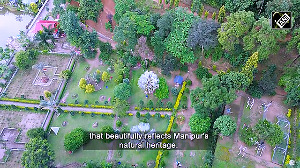Smugglers from India, Nepal and China are sneaking into Ascot wildlife sanctuary in Uttaranchal's Pithoragarh district, not for any rare animal but in search of a parasitic fungus with aphrodisiac traits, whose growing extraction and international demand have threatened it with extinction.
Two Nepalese labourers were arrested recently at Landsdowne town of Pauri district for smuggling yartsa gombu, a half plant and half insect popularly known as desi viagra, for its aphrodisiac qualities.
This is not an isolated incident. Wildlife officials indicated that in the face of its growing demand in the international market, smugglers from Nepal, China and India are sneaking into the sanctuary to illegally extract yartsa gombu, found in the Alpine region of eastern Kumaoan and parts of Chamoli district at a height ranging between 3500 to 4500 meters.
With widespread extraction of yarstsa gombu, known as cordyceps sinensis in scientific parlance, continuing unabated, scientists have warned that the species is now facing extinction.
"Yartsa gombu is a rare species, which has tremendous medicinal values to cure heart, asthmatic and other diseases besides its aphrodisiac use. It is a very intricate balance of nature in which a fungus grows on a caterpillar," said Professor G S Rawat of the Wildlife Institute of India.
Though the Uttaranchal government has banned extraction of the yarsta gombu, its illegal extraction in the area is going on for decades. "If the trend continues for another two to three years, then this species will become extinct," warned Rawat.
Agrees Dr H B Naithani, a senior scientist in the Forest Research Institute. "The government must do something to stop widespread extraction of this species," he said.
Smugglers usually pluck the whole of the caterpillar, along with fungi, and sell them in the markets of Hong Kong at a very hefty price. Though there had been scramble for its conservation, it is yet to be declared in the endangered list, Naithani said.





